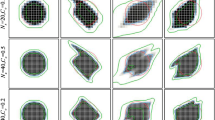Abstract
The numerical simulation of wake and free-surface flow around ships is a complex topic that involves multiple tasks: the generation of an optimal computational grid and the development of numerical algorithms capable to predict the flow field around a hull. In this paper, a numerical framework is developed aimed at high-resolution CFD simulations of turbulent, free-surface flows around ship hulls. The framework consists in the concatenation of “tools”, partly available in the open-source finite volume library OpenFOAM®. A novel, flexible mesh-generation algorithm is presented, capable of producing high-quality computational grids for free-surface ship hydrodynamics. The numerical frame work is used to solve some benchmark problems, providing results that are in excellent agreement with the experimental measures.
Similar content being viewed by others
References
Berberović E, van Hinsberg NP, Jakirlić S, Roisman IV, Tropea C (2009). Drop impact onto a liquid layer of finite thickness: Dynamics of the cavity evolution. Physical Review E, 79, 036306.
Brackbill JU, Kothe DB, Zemach C (1992). A continuum method for modeling surface tension. Journal of Computational Physics, 100, 335–354.
Hirt C, Nichols B (1981). Volume of fluid (VOF) method for the dynamic of free boundaries. Journal of Computational Physics, 39, 201–225.
Jackson A (2012). A comprehensive tour of snappyHexMesh. 7 th OpenFOAM Workshop Lecture, Darmstadt.
Kim SE, Rhee BJ, Shan H, Gorski J, Paterson EG, Maki K (2010). A scalable multiphase ranse capability based on object-oriented programming and its applications to ship hydrodynamics. Gothenburg 2010 a Workshop on Numerical Ship Hydrodynamics, Gothenburg, 629–634.
Kim SE, Rhee SH (2002). Assessment of eight turbulence models for a three-dimensional boundary layer involving cross-flow and streamwise vortices. 40 th AIAA Aerospace Sciences Meeting and Exhibit, Reno, Nevada, USA, AIAA Paper 2002-0852.
Larsson L, Stern F, Visonneau M (2010). Numerical ship hydrodynamics. Gothenburg 2010 a Workshop on Numerical Ship Hydrodynamics, Gothenburg, 1–32.
Lee SB (2013). Practical application of openfoam to prediction of hull resistance. 8th OpenFOAM Workshop Lecture, Jeju.
Lombardi M (2012). Numerical simulation of a sailing boat: free surface, fluid structure interaction and shape optimization. PhD thesis, École Polytechnique Fédérale de Lausanne, Lausanne, 25–66.
Menter F, Kuntz M, Langtry R (2003). Ten years of industrial experience with the SST turbulence model. Turbulence, Heat and Mass Transfer 4: Proceedings of the Fourth International Symposium on Turbulence, Heat and Mass Transfer, Antalya, 625–632.
Muzaferija S, Peric M (1999). Nonlinear water wave interaction. WIT Press, Southampton, UK, 59–100.
Park S, Park SW, Rhee SH, Lee SB, Choi JE, Kang SH (2013). Investigation on the wall function implementation for the prediction of ship resistance. International Journal of Naval Architecture and Ocean Engineering, 5, 33–46.
Paterson E, Smith K, Ford S (2009). Simulation of wakes, wave impact loads, and seakeeping using OpenFOAM. 4 th OpenFOAM Workshop Lecture, Montreal. Press WH
Teukolsky SA, Vetterling WT, Flannery BP (2007). Numerical recipes: The art of scientific computing. 3rd ed., Cambridge University Press, New York, 1117–1128.
Rusche H (2002). Computational fluid dynamics of dispersed two-phase flows at high phase fraction. PhD thesis, Imperial College of Science, Technology & Medicine, Department of Mechanical Engineering, London, 147–178.
Weller HG, Tabor G, Jasak H, Fureby C (1998). A tensorial approach to computational continuum mechanics using object-oriented techniques. Computer in Physics, 12(6), 620–631.
Wilcox DC (1988). Reassessment of the scale-determining equation for advanced turbulence models. AIAA Journal, 26(11), 1299–1310.
Wilcox DC (1998). Turbulence modeling for CFD. 2nd ed., DCW Industries Inc., La Canada, CA, 84–87.
Author information
Authors and Affiliations
Corresponding author
Additional information
Norman Del Puppo is presently a PhD candidate at School of Engineering and Architecture, University of Trieste. His research interests include computational ship hydrodynamics, hull form optimization and grid generation based on OpenFOAM.
Rights and permissions
About this article
Cite this article
Del Puppo, N. High resolution ship hydrodynamics simulations in open source environment. J. Marine. Sci. Appl. 13, 377–387 (2014). https://doi.org/10.1007/s11804-014-1278-2
Received:
Accepted:
Published:
Issue Date:
DOI: https://doi.org/10.1007/s11804-014-1278-2




